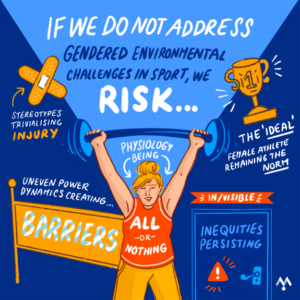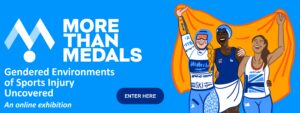Authors: Stephanie E. Coen, Victoria Downie, Lucy Follett, Steve McCaig, Joanne L. Parsons
Why is this study important?
Women and girls remain at elevated risk of some sports injuries compared to their male counterparts, including anterior cruciate ligament (ACL) rupture, concussion, and ankle sprain. Research into injury disparities has traditionally focused on sex-based biological explanations (e.g., menstrual cycle, anatomy, biomechanics).
A gendered environmental approach widens the lens to also consider how the gendered conditions of society and sport contribute to women’s injury risk (Parsons et al., 2021). These social, cultural, and material factors are a largely untapped opportunity for supporting athlete health, but the whole notion of ‘gendered environments’ can seem…well…rather nebulous. So, where do we start? How do we address them in practice?
In this study, we drew on the perspectives of elite women athletes to identify features of gendered environments that mattered in their sports careers and understand how these connected to injury (Coen et al., 2024).
How did the study go about this?
We carried out in-depth interviews with 20 women athletes from 11 different sports who recently retired from the UK high performance system. Data were analysed using qualitative coding to identify themes, together with ‘poetic transcription’ to create research poems that described each theme in athletes’ own words.
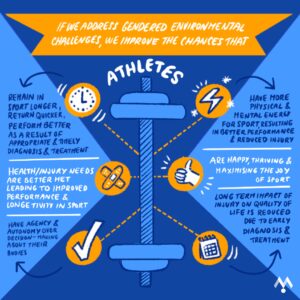
What did the study find?
We found five themes connecting gendered environments to sports injury:
- Stereotypes trivialise injury: Gender stereotypes embedded in the sport system contribute to minimising and mischaracterising athletes’ injury concerns, creating barriers to early diagnosis and treatment. (e.g., “They didn’t say it’s in your head, but essentially that was the diagnosis.”)
- Physiology is all or nothing: Women’s health and injury concerns could at once be reduced to reproductive physiology (e.g., menstrual cycle) while at the same time women’s physiology could be erased, leading to gaps in meeting athletes’ needs. (e.g., “Go on the pill so we don’t have to sort that.”)
- The ‘ideal’ female athlete: Social norms that value idealised behavioural and physical attributes in women athletes can result in missed opportunities to identify and prevent injuries. (e.g., “As a woman, you had to be soft, kind, and caring.”)
- In/visible inequities: Gender disparities in opportunities and resources in sport continue to position women like “second class citizens,” increasing individual burden to stay injury-free (e.g., “The women always have to work around the men.”)
- Uneven power dynamics: Women’s injury experiences are deeply entangled with the gendered organisational hierarchies of sport, reflected in how information is communicated and whose expertise is considered authoritative when it comes to injury. (e.g., “The younger male coaches just absolutely hated a more experienced female athlete questioning their knowledge.”
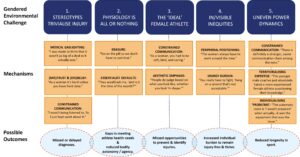
What are the key take-home points? What can you do?
Sport staff and athletes can use these themes as a framework to help label gendered experiences that may otherwise be hard to articulate in a tangible way.
To assist in this task, we translated our research into a publicly available online resource. Designed as a multimedia exhibition, More Than Medals: Gendered Environments of Sports Injury Uncovered invites visitors into women athletes experiences through a combination of original poetry constructed entirely of direct athlete quotes, voiced by actors, and illustrated through original artwork. Each virtual exhibition room is dedicated to a specific challenge and concludes with questions prompting reflection for turning insight into action.
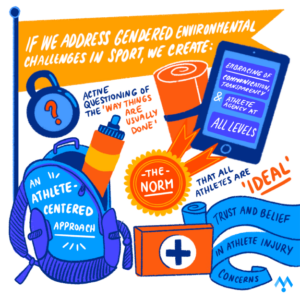
What can you do with More Than Medals?
- Reflect on your own practice—is there anything you might reconsider about the usual way of doing things in light of what you learned?
- Use the exhibition to start a conversation with colleagues or athletes about gendered environments in your sport context.
- Share amongst your team to raise awareness about gendered environments.
- Tell others one insight you took away from the exhibition to encourage them to learn more.
REFERENCES
Coen, S. E., Downie, D., Follett, L., McCaig, S., & Parsons, J. L. (2024). Gendered environmental pathways to sports injury: Insights from retired athletes in the UK high performance context. British Journal of Sports Medicine. 58, 1505-1517. doi: 10.1136/bjsports-2024-108717
Parsons, J., Coen, S. E., & Bekker, S. (2021). Anterior cruciate ligament injury: Toward a gendered environmental approach. British Journal of Sports Medicine, 55, 984-990. bjsm.bmj.com/content/55/17/984
